|
 |

SAT URUGUAY

Dear Travel Partner!
Today we would like to introduce our colleagues in Montevideo.
In 2005, we established our Incoming office SAT Uruguay in this beautiful, small destination, somewhat unknown, still the hidden gem of our portfolio. Uruguay is filled with interesting places, culture, nature, wildlife, wine regions and endless beaches.
SAT Uruguay is not only our local Incoming office, but also our Consolidation office. Some of the tours we offer are handled centrally from here. Our intercultural team on site includes many German native speakers, who support both our local offices and our clients.
Meet the SAT Uruguay team members and find out about their favourite places in their home country. Let yourself be surprised by the diversity this country has to offer international travellers.
And, if you feel like you would like to experience it yourself or offer it to your clients, please contact our local experts in Montevideo. They will be happy to create bespoke travel programs to explore their destination and neighbouring countries.
Your SAT team
|
 |
|
 |
|
CHRISTINA HERBST, General Manager SAT Uruguay
|
 |
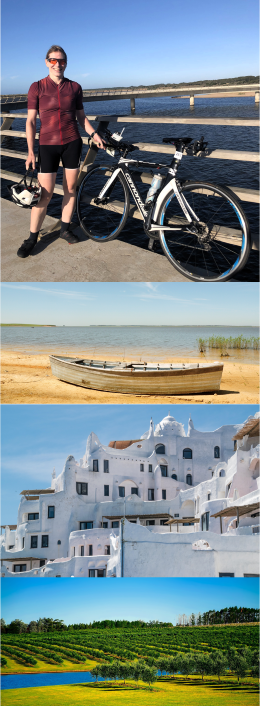 |
|
Greetings from Uruguay!
I already had the pleasure of introducing you to our Argentina office a couple of weeks ago. Being the General Manager of SAT Argentina, I am also in charge of our office in the neighbouring country Uruguay.
This small but lovely country has plenty of attractions to offer – sharing a border with Brazil in the north/northeast and with Argentina in the west. The remaining part of the country is surrounded by the beautiful coastline of the Atlantic Ocean as well as the shores of the Rio de la Plata River, which divides Uruguay and Argentina and also its capital cities, Montevideo and Buenos Aires. The
Rio de la Plata also provides the scenery for the
broad Rambla street of Montevideo which is an excellent place for having a walk, doing sports or drinking some
Mate tea, which is the trademark of almost each and every Uruguayan citizen. Going further west,
Colonia del Sacramento is a testament to the colonial history marked by the Portuguese and the Spanish, which is why it has been crowned as a UNESCO World Heritage Site. However, there is so much more to discover! My colleagues will give you an overview of their favourite spots in this newsletter.
The two countries I oversee, Argentina and Uruguay, have a lot in common, such as the love of
Mate and the distinctive Spanish accent. However, whenever I travel to Uruguay to meet with the team, I start to slow down a bit. Life is pretty laid-back in Uruguay and I really enjoy the great views over the Rio de la Plata that Montevideo has to offer. My absolute happy place is
Punta del Este going further East. This is where the Rio de la Plata River flows into the Atlantic Ocean. The coastline provides spectacular sunsets and was the setting chosen by artist Carlos Páez Vilaró for
Casapueblo, a complex of white buildings along the shore of the Punta Ballena hill with stunning views. The artist himself called it
his inhabitable sculpture.
As for me, being a triathlete, I love the area around Punta del Este as it´s just the perfect spot to swim, bike and run. So, whenever I can escape from the busy city life of Buenos Aires, I come here to enjoy a run along the Rambla coastline passing by the Marina to the point where the Rio de la Plata meets the Atlantic Ocean, long bike rides around the area, and a swim in the ocean.
|
 |
|
 |
|
CECILIA NICHE, Manager Consolidation
|
 |
|
My name is Cecilia, and I’ve been working in the Consolidating office of SAT Uruguay for over 13 years. I love our capital,
Montevideo. It is a beautiful city, quiet, but with lots to do and discover, even as a local, with lots of
green areas and on the
banks of a river that looks like a sea. Montevideo is a city with a great and very complete
gastronomic offer, for example in the old town (Ciudad Vieja) or in the city centre, you can find restaurants of Peruvian, Vietnamese, Korean, and Venezuelan gastronomy, restaurants specialising in seafood, wine bars with excellent local and regional wines, along with the classic Uruguayan "parrilladas". Some of them are in the most unexpected places, my favourites: a cafeteria in what used to be an old pharmacy, which keeps its antique wooden shelves and glass jars as decoration; or a restaurant in a plant nursery, where the tables are arranged in the middle of the plants and trees
for sale. And I love Montevideo for its
bookstores, small shops with second-hand books literally from floor to ceiling, huge bookstores housed in beautiful old recycled houses. In short, Montevideo is the perfect city for foodies and book lovers!
|
|
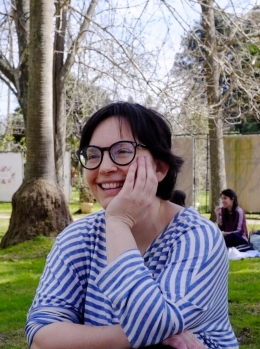 |
 |
|
 |
|
SABINE THEISS, Product Development Manager
|
 |
 |
|
Greetings from Sabine, I am originally German but have been living in Uruguay for more than 18 years out of love for the country and its people. I have been working for SAT for more than 11 years. Today, my role at SAT is to work with our product teams across South America to further develop our product and consolidate special programs.
One of my favourite places is located at Colonia del Sacramento, where I lived for several years. The westernmost part of the city's Old Town is called La Punta, where a lovely stone railing separates the pedestrian walkway from the La Plata River. From here you have a wonderful view, on a clear day you can even see Buenos Aires in the distance. It is the perfect place to enjoy the sunset or sip on a mate with friends. Especially on weekends it is a popular hang-out spot for young people and also a much-photographed motif. Not far away from Colonia
lies Carmelo, where several interesting
wineries are located. I particularly like the Almacen de la Capilla which has a unique atmosphere and style as it is an old grocery store. It is a cosy place perfect to taste the typical Uruguayan Tannat wine together with a delicious variety of cheeses, ham and olives. A completely different but also wonderful spot for me is Punta del Este. I love the sandy beaches, but also the buzzing streets of the centre when the sun goes down and the temperature is ideal for strolling around. During summer, shops, stores and restaurants are open until
late and there is always something to do or see.
|
 |
|
 |
|
MARIA DEL MAR, Manager SAT Uruguay Incoming
|
 |
I am María del Mar Silva and I have been working at SAT Uruguay since July 2018.
It is quite difficult to say which of the beautiful places in Uruguay is my favourite one. Without a doubt, I love living in Montevideo, the Uruguayan capital has a mix of architectural influences reflected in its modern skyscrapers and historic buildings. The city offers a great variety of cultural activities, music, and nightlife.
I love to sneak around museums, most of which are free to visit. I also enjoy going to Candombe street rehearsals, and dance along the beat of the drums. As you can see, Montevideo has a lot of places to discover!
Whenever I feel like taking some time out of the city I love to go to Cabo Polonio, my second favourite place in Uruguay.
El Cabo is a National Park located 4h away from Montevideo and it is a very special place because you only can get to this fisherman town by 4x4 trucks, there is no traffic as there are no cars. There are very few inhabitants, most of the houses have neither electricity nor running water.
It is the ideal place to slow down and the beach is amazing.
|
|
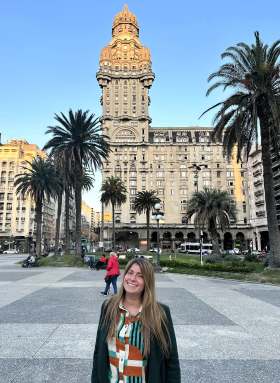 |
 |
|
 |
|
FLORENCIA SPILLER, Senior Account Executive Consolidation
|
 |
|
Uruguay is a small country with a lot of coastline. We have river beaches, estuary beaches, and ocean beaches!
One of my favourite places in Uruguay is Fray Bentos on the banks of the Uruguay River.
The east coast of Uruguay is fantastic for cycling, going to the beach, and also for a tour of the migratory history of this country!
Fray Bentos is home to a World Heritage Site, the famous Museum of the Industrial Revolution, in homage to the Anglo meat packing plant that produced corned beef for decades.
Immigrants of 52 different nationalities worked there, and later populated the coast of Uruguay, such as the German colonies Ombu and Gartental or the Russian colony San Javier.
The beach resort of Las Cañas is ideal for an afternoon on the beach, after cycling along the scenic route that connects it with the city of Fray Bentos.
The sunsets over the Uruguay river are worth seeing!
|
|
JOSEPHINE STROHMEIER, Account Executive Consolidation
|
I've been working at SAT Consolidation for about a year and a half and I am responsible for the processing of various Seat-In-Coach tours.
For a Sunday in Montevideo, I can highly recommend the weekly market of Tristan Narvaja. The market is now one of the most popular in the city and was opened in 1909. Fruits and vegetables were sold here. Today, in addition to food, you can find many other things such as plants, clothes, toiletries, books, vinyls, and inexpensive antiques.
Personally, I like to go to the market early in the morning when it is not too crowded. There I drink freshly squeezed fruit juice and look at hand-made jewellery, bags and clothes of the street vendors. Around noon, it gets more crowded. Now you can also listen to street musicians and Candombe groups. Many food stalls cater for your physical well-being.
As Uruguay is a country of immigrants, the cuisine is also multicultural.
|
|
 |
|
ALEJANDRO ALBERTI, Account Executive Consolidation
|
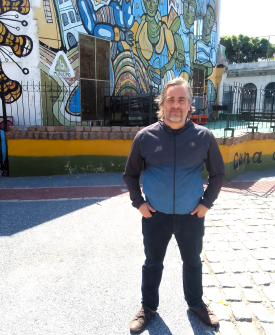 |
|
My name is Alejandro and one of my favourite places in Uruguay is the coast between Balneario Solis and Piriapolis.
It is the place where Cuchilla Grande, an impressive mountain chain, meets the sea.
As a result, the coastline is formed by a unique mix of rocks, coves, and beaches, with the hills as the background.
The town of Piriapolis has a typical Mediterranean charm, with low-rise houses.
Insider's tip:
the Pittamiglio Castle is located in the surroundings of Piriapolis in Las Flores.
Pittamiglio was an architect and close friend of Piria, the founder of Piriapolis. They were both spiritualists and alchemists and created this intriguing castle.
Another place I like is the Barrio Sur (neighbourhood) of Montevideo, the place where the most important carnival street parade takes place.
Here the Uruguayan music tango and candombe were born.
|
|
DIEGO FERNANDEZ, Account Executive Incoming
|
 |
Hi! I am Diego. I was raised in a multicultural environment and I have always liked tourism and nature altogether. Now I am excited to be a part of SAT and to be able to show my country to our visitors.
My favourite place in Uruguay is Punta Colorada and, although I think the entire Uruguayan coast has a very unique beauty worth discovering, Punta Colorada is special to me because of my childhood memories. In this tiny town, with only one restaurant, you will find a very rich and cared-for biodiversity and a peaceful environment.
If you are lucky enough, during spring you can see Noctilucas glowing at night, a very special type of microscopic marine organism that glows blue in the waves as they approach the coast. This place will not disappoint you; especially if you are into walks or other open-air activities such as fishing, hiking, swimming, or sunbathing. Or maybe you prefer to chill in the shade and drink mate as you let the healing nature of this place speak for itself. Come visit!
|
|
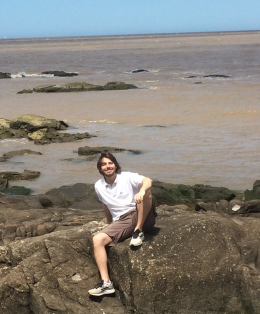 |
 |
|
 |
|
HIDDEN TREASURES: The Lunarejo Valley
|
 |
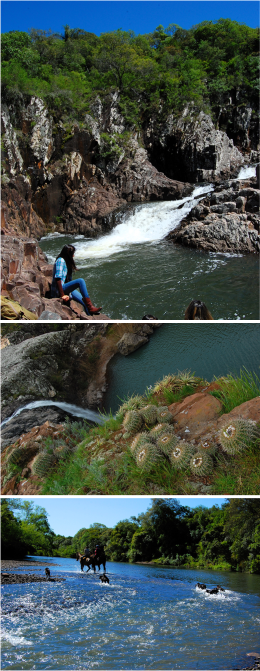 |
|
The Lunarejo Valley is a protected nature reserve in the north-west of Uruguay, close to the border with Brazil.
This area serves as a
biological corridor for subtropical species of flora and fauna to enter the country from Brazil. The valley is famous for its breathtaking scenery, characterized by rivers, creeks, and flat-topped hills that border "quebradas", narrow valleys shaped by river courses. These gorges have been carved out of basaltic rock, with steep slopes and reliefs, that give way to caves and waterfalls. The region also boasts different types of vegetation, such as grasslands, forests, and shrubland. This diverse landscape is home to an abundance of wildlife, including more than
150 species of birds, such as the sharp-tailed grass tyrant, the blue-winged macaw, and the broad-winged hawk. Several
rare species stand out: among the amphibians the Uruguayan frog and the Devincenzi's toad; among the reptiles the rattlesnake; and among the mammals, the small anteater, the molle-tailed tatú, the margay cat, the coati, the coendú and the guazubirá.
To explore the Lunarejo Valley, there are several short trails to choose from. The
Boquerón Hill Trail offers an unparalleled view of the Lunarejo Valley. At a length of 1.3km (0.8 mi), this is an easy route to start with. At a similar length of 1.5km (0.9 mi), the
Paredones
Trail takes you past rivers, with plenty of opportunities to spot wildlife. The
De Los Helechos Trail starts in the historical setting of Masoller and heads downhill to a ravine with a natural pool fed by the Lunarejo River. Along the 1.4km (0.86 mi) long route, you can spot large-sized species of ferns as well as a variety of birds. The
Balcones de Lunarejo Trail is for those who prefer to observe their surroundings from horseback. If you want to refresh yourself, the 1.4km (0.86 mi) long trail offers a detour down to a gorge with a waterfall.
To visit the Lunarejo Valley, we recommend taking a rental car from Montevideo to Tacuarembó, and enjoying interesting stops along the way such as Piriápolis, La Coronilla, or Mariscala.
For suggestions on self-drive tours to the Lunarejo Valley and more, please contact us!
Picture credit: Intendencia de Rivera
|
 |
|
 |
|
5 THINGS TO DO FOR 0 DOLLARS!
|
 Experience authentic Candombe in Uruguay. Many neighbourhoods have their own Candombe groups that practice and perform regularly, especially on Sundays. You can go to a street rehearsal and dance some Candombe.
 At the iconic El Facal restaurant, a tango dancing couple performs on the sidewalk outside the bar at noon from Monday to Saturday.
 Enjoy the panoramic view of Montevideo . Take the elevator to the 22nd floor of the headquarters building of the Montevideo City Hall building, which is 77 metres high. It is a great spot to see Montevideo from a different angle .
 Uruguay has a wide range of museums with free admission. In Montevideo you can visit the Taranco Museum or the Museum of Visual Arts. In Punta del Este, we recommend the Ralli Museum and the MACA.
 Discover Uruguay's beaches. With its extensive coastline on the Río de la Plata and the Atlantic Ocean, the country has many beautiful beaches where you can swim and enjoy unique sunsets.
|
 |
|
 |
 |

|
 |
|
 |
... Tango and Candombe have been declared Intangible Cultural Heritage of Humanity by UNESCO. Argentina and Uruguay jointly nominated tango, and Uruguay nominated candombe.
... More than 80% of Uruguay's territory is pastureland. More than 400 years ago, the Spaniards introduced the first cattle to the lands of the Río de la Plata, and over time, cattle ranching became an important source of wealth. The rites and traditions associated with the meat have created a unique identity that today is part of the country's Intangible Cultural Heritage.
... In 1930, the first Soccer World Cup took place in Uruguay, from June 13 to 30. Only 13 teams participated - Uruguay, Belgium, Yugoslavia, Argentina, Romania, Mexico, the United States, Bolivia, Brazil, Chile, France, Peru, and Paraguay. In the final, hosts and pre-tournament favourites Uruguay defeated Argentina 4–2 in front of 68,346 spectators, to become the first nation to win the World Cup.
... Uruguay has the longest Carnival in the world, which lasts 40 days. During this period, people gather around the tablados, specially set up stages where different groups of artists perform at night in multiple towns and cities across the country. The murgas are large groups of artists and comedians who are particularly famous and some of them perform internationally. This is the case of Agarrate Catalina, Falta y Resto, Curtidores de Hongos, Asaltantes Con Patente, among others.
... Uruguay was the first Latin American country to legalise civil unions for same-sex couples. It is also known as one of the most LGBTI-friendly countries.
... The wine country of Uruguay is the fourth largest wine producer in South America, best known for the red wines made from the Tannat grape variety, which was introduced by Italian and Basque immigrants back in 1870. Other popular grape varieties include Merlot, Chardonnay, Cabernet Sauvignon, as well as white wines from Albarino such as Sauvignon Blanc.
|
 |
|
 |

|
 |
|
 |
South American Tours - Global Sales Office
South American Tours GmbH | Kaiserstr. 23 | 60311 Frankfurt am Main | Germany
Phone: +49 (0) 69 4058970 | Fax: +49 (0) 69 40589799
Mail: sales@southamericantours.com | www.southamericantours.com
South American Tours - Sales Office North America
Mail: sales-america@southamericantours.com
South American Tours - Sales Office Italy
Mail: sales.italy@southamericantours.com
Copyright © South American Tours 2012-2023
Imprint
South American Tours de Uruguay Agencia de Viajes S.A. | Buenos Aires 618, Piso 2, Oficina 201 | 11000 Montevideo | Uruguay
Tel.: +59 82 91 60 050 | Fax.: +59 82 91 55 406 | E-mail: info@southamericantours.com
Managing Director: Federico Büker | Registered Office: Montevideo | Local Court: Montevideo | Commercial Register: 1194 (Ministry of Tourism) | VAT identification no.: 215224020014

|
 |
|
Protection of data privacy and cancellation of the subscription:
This message has been sent to jzenner@southamericantours.com. If you do not want to receive mails in the future you can unsubscribe by clicking
here.
|
|
|
 |
|
 |
 |
|
|